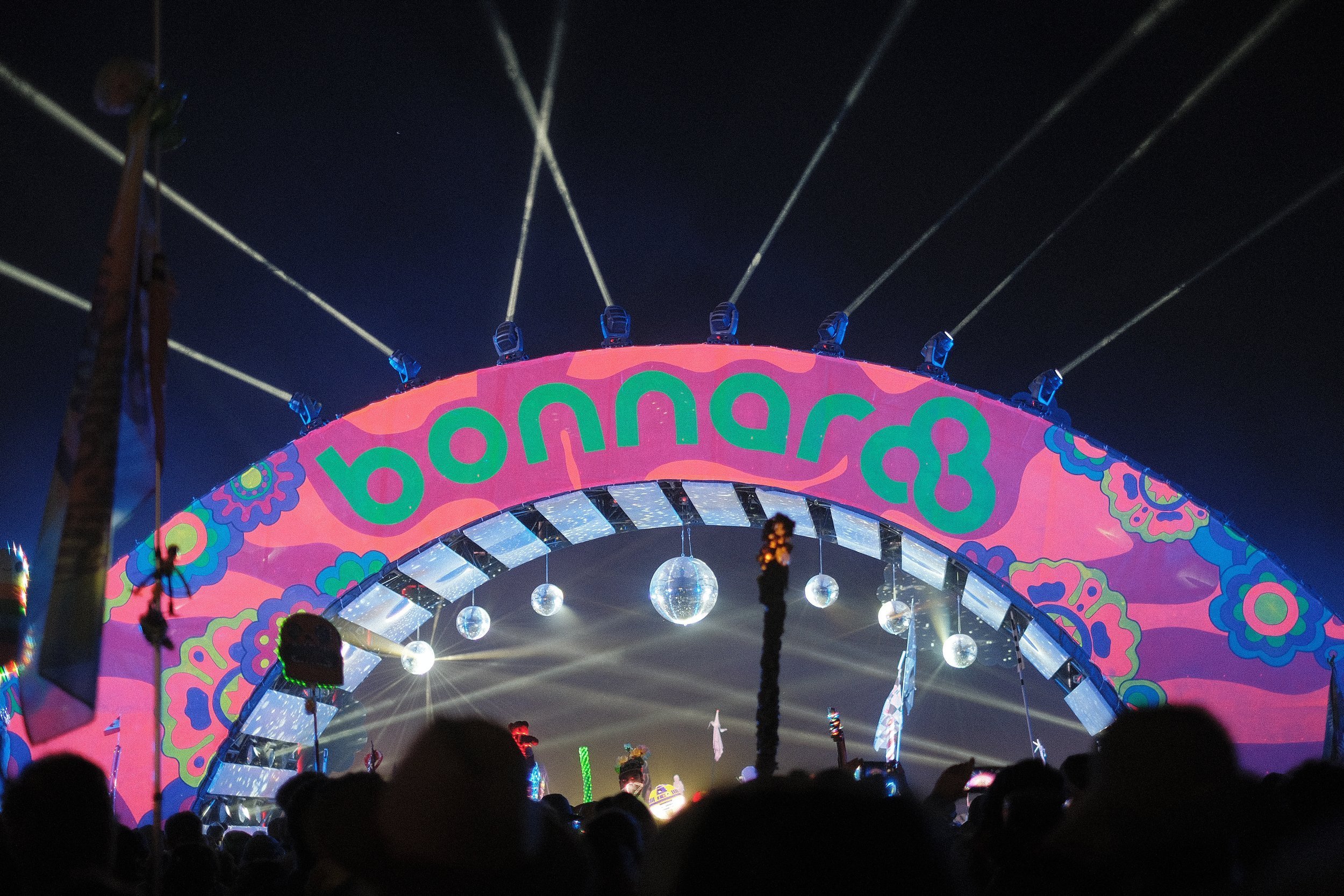Rhythm and Reflection: A Path Forward For Bonnaroo
For fifteen years across thirteen consecutive festivals, Bonnaroo has been a rhythm in my life—a steady, grounding presence that returns each summer. It’s where I’ve grown, reflected, celebrated, and recharged. Across all those years, I’ve come with friends, my partner, and twice solo. I’ve camped in the blazing heat, waited in traffic for nine hours, danced under the stars, and stood in awe of artists who turned the farm into something sacred. I’ve stood shoulder to shoulder in the pit, and I’ve wandered the edges of Centeroo, sometimes stealing a quick nap in the shade.
And through it all—the early mornings, muddy boots, shared meals, and small joys—I’ve come to know Bonnaroo not as a place I go, but as a place I belong. Even when the lineups didn’t grab me, the spirit of the festival did. Even in years with uncertainty or exhaustion, something about the farm always brought me back into alignment. This space has carried me through celebrations, losses, turning points, and quiet moments of growth I didn’t even recognize until later.
It’s not just nostalgia that keeps pulling me back. It’s the feeling of arriving on the farm and knowing I’ll find a version of myself waiting there—open, present, alive. And it’s from that place of love and connection that this essay takes shape. What follows is a reflection rooted in care and sparked by a cancellation that left many of us stunned. On Friday, for the second time in just five years, the Bonnaroo Music and Arts Festival was canceled in the midst of festivities already underway. Not because of a once-in-a-generation weather event, but because the land couldn’t hold what was asked of it. That disorienting, emotional, and abrupt moment raised questions that extend far beyond a single weekend. Questions about preparedness. About care. About whether the Bonnaroo we all love is being protected in the ways it needs to be.
This short essay is a hope that Bonnaroo continues to evolve in a way that honors everything it’s meant to those of us who keep showing up, not just for the music, but for the meaning it’s created, for the connections, clarity, and perspective that stay with you long after the final set.
Loving something deeply means not just celebrating its highs, but caring enough to speak honestly about where it falls short. Over the years, I’ve seen Bonnaroo shift, from a scrappy, lovingly oiled machine to a production that, at times, feels like it’s traded the uniqueness that once defined it for efficiency, or worse, for something easier and less intentional. Change is natural, even necessary. But as the festival has evolved, there have been moments—especially in recent years—where the spirit of care hasn’t always kept up.
One of the most persistent and overlooked challenges at Bonnaroo is the process of exiting the farm. Even after all these years, there’s still no clear system—no signage, no coordinated flow, just long lines of vehicles inching toward uncertainty. And this year, that lack of structure was compounded by poor communication. When the festival was canceled mid-festival, and the grounds were already starting to deteriorate from rain, people were left trying to find their way out with little to no guidance. For first-timers, it was confusing. For longtime attendees, it was disappointing. But more than anything, it was concerning. In moments like that, the absence of a plan isn’t just inconvenient, it can feel unsafe.
That same disconnect showed up again this year, during the cancellation. I was on the farm when the announcement was made, and the hours that followed felt aimless. We stood in the aftermath of the rain, scanning for answers. Some people, myself included, tried to retrieve items from lockers, only to be met with vague instructions, conflicting updates, and a growing sense that no one had a clear plan.
But beyond communication, the most urgent and revealing issue this year was the land itself. According to meteorologists, Manchester received just one inch of rain. And yet, what followed was a complete unraveling of the grounds. Campsites flooded into ponds. Roads and walkways became impassable. The basic infrastructure couldn’t hold, and that exposed something deeper.
After thirteen festivals, I’ve seen plenty of changes but have watched the property remain largely unchanged, even as the festival has grown in ambition. The conditions we saw in 2025 weren’t the result of an extreme weather event, they were the result of years without meaningful reinvestment in the core infrastructure. And while I fully agreed with the decision to cancel for safety reasons, it was heartbreaking to see how easily everything fell apart. It shouldn’t have come to that.
This moment needs to be more than a temporary setback, it needs to be a turning point. Bonnaroo must take a hard look at whether it’s truly preparing this land to support the future of the festival. I would never want the event to leave the farm. It’s sacred to me and to so many others. But if the land can’t be protected and equipped to carry what we continue to ask of it, the soul of Bonnaroo is at risk, not because of the weather, but because of the lack of readiness to meet it. That spirit—the heart of what makes this festival special—has to be matched by infrastructure, by the very ground we walk, camp, and dance on. Without serious investment, we’re not just gambling with storms, we’re gambling with trust.
Bonnaroovians have heard the phrase “prepare thyself.” And year after year, the community does. We show up ready for whatever comes. But now it’s time for the organizers of this festival to prepare itself for the future. That means taking the right steps, investing where it counts, and making sure the next time something unpredictable happens, we’re not scrambling—we’re ready.
All of this connects back to how people experience and perceive Bonnaroo, not just on the ground, but in their hearts. The festival’s identity used to be unmistakable: weird, wild, full of soul. But since around 2016, there’s been a slow shift. A smoothing-out. An effort to fit Bonnaroo into a mold it was never meant to occupy. The brand has started to feel more templated, more generic, like it’s trying to compete instead of just being itself. And yet, the reason people keep coming back isn’t because Bonnaroo is like other festivals—it’s because it isn’t.
A strong festival can sell out. But the ones that last, the ones that mean something, build trust and identity. Bonnaroo has always been that kind of festival. It didn’t rely on flash, it created something people believed in. If it wants to protect that legacy, it doesn’t need reinvention. It needs reconnection and reinvestment to uphold its reputation and the Bonnaroo brand.
And perhaps most importantly, it needs to invite its community into that process. The people who return year after year aren’t just customers—they’re stewards. I would love to be involved more directly, from a creative and experience perspective, alongside others who understand what this space means. Bonnaroo’s greatest strength has always been its people. If the festival wants to evolve for a new generation of Bonnaroovians while staying grounded, it has to trust the community that’s kept it alive.
Bonnaroo is where I began a lone journey in 2011, not knowing what I was walking into, only to find confidence under the sun and stars. It’s where I felt something close to transcendence during Radiohead’s 2012 set, where time seemed to bend and everything else faded. Where Kendrick Lamar’s 2015 performance hit with raw force and clarity. And where My Morning Jacket, during their 2023 return, stretched a late-night into something sacred—something that felt like it belonged only to those who stayed awake long enough to receive it.
It’s the taste of Spicy Pie at just the right moment. The peace of a quiet morning walk to the arch. The feeling of being surrounded by strangers who, somehow, already feel like your people.
There have been challenges too—long waits in traffic, brutal heat, a heartbreaking cancellation without clear guidance. But through all of it, I return. Because Bonnaroo isn’t just a festival. It’s been one of the most grounding, formative forces in my life.
That’s why this moment matters. The reflections, the questions, the critique—they come from love. From a hope that Bonnaroo can continue to grow in ways that honor what’s always made it feel like home. I’ll always be a Bonnaroovian, and I’ll keep coming back to the farm for as long as I can.
And maybe, for anyone reading, whether you help shape the future of the festival or just carry it with you in memory, this can be a reminder: of what first drew us in, of the joy in the small things, and of the magic that lives in this place when it’s at its best.
Author Note:
DeShawn Oravetz is a New Orleans–based Creative Director and multidisciplinary storyteller with over a decade of experience blending brand strategy, visual media, and cultural insight. His work centers on identity, belonging, and emotional storytelling, both in his professional practice and personal projects. He has attended thirteen consecutive Bonnaroo festivals, and this essay was written in the wake of the 2025 mid-festival cancellation. It serves as both a reflection on a space that has shaped him and a hopeful critique aimed at protecting its future.



